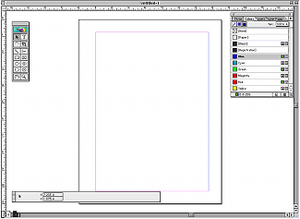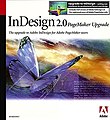Details about the Most Useful DTP Softwares by us
1. Adobe PageMaker

PageMaker 7.0 running on Mac OS 9
| |
| Original author(s) | Aldus |
|---|---|
| Developer(s) | Adobe Systems |
| Last release | 7.0.2 / 30 March 2004 |
| Development status | Discontinued |
| Operating system | Windows Vista and earlier Mac OS 9 OS/2 v3.01 |
| Type | Desktop publishing |
| License | Trialware |
| Website | www |
PageMaker was one of the first desktop publishing programs, introduced in 1985 by Aldus,[2] initially for the Apple Macintoshand, in 1987, for PCs running Windows 1.0.[3] As an application relying on a graphical user interface, PageMaker helped to popularize the Macintosh platform and the Windows environment.[4][5]
PageMaker relies on Adobe Systems' PostScript page description language.
In 1994, Adobe Systems acquired Aldus and PageMaker.
Release history
Aldus Pagemaker 1.0 was released in July 1985 for the Macintosh and in December 1986 for the IBM PC.
Aldus Pagemaker 1.2 for Macintosh was released in 1986 and added support for PostScript fonts built into LaserWriter Plusor downloaded to the memory of other output devices.PageMaker was awarded an SPA Excellence in Software Award forBest New Use of a Computer in 1986.
In October 1986, a version of Aldus was made available for Hewlett-Packard's HP Vectra computers. In 1987, Aldus was available on the Digital Equipment's VAXstation computers.
Aldus Pagemaker 2 was released in 1987.
Until May 1987, the initial Windows release was bundled with a full version of Windows 1.0.3; after that date, a "Windows-runtime" with no task-switching capabilities was included. Thus, users who did not have Windows could run the application from MS-DOS.
Aldus Pagemaker 3 for Macintosh was shipped in April 1988. PageMaker 3.0 for the PC was shipped in May 1988[13] and required Windows 2.0, which was bundled as a run-time version. Version 3.01 was available for OS/2 and took extensive advantage of multithreading for improved user responsiveness.
Aldus PageMaker 4 for Macintosh was released in 1990 and offered new word-processing capabilities, expanded typographic controls, and enhanced features for handling long documents. A version for the PC was available by 1991.
Aldus PageMaker 5.0 was released in January 1993.
Adobe PageMaker 6.0 was released in
End of development
1995. Adobe PageMaker 6.5 was released in 1996.
Support for versions 4.0, 5.0, 6.0, and 6.5 is no longer offered through the official Adobe support system. Due to Aldus' use of closed, proprietary data formats, this posessubstantial problems for users who have works authored in these legacy versions.
The final version made available is PageMaker 7.0, released 9 July 2001, though updates have been released for the two supported platforms since.
The Macintosh versio
n runs only in Mac OS 9 or earlier; there is no native support for Mac OS X, and it does not run at all on Intel-based Macs. It does not run well underClassic, and Adobe recommends that customers use an older Macintosh capable of booting into Mac OS 9. The Windows version supports Windows XP, but according to Adobe, "PageMaker 7.x does not install or run on Windows Vista.
Development of Pagemaker had flagged in the later years at Aldus and, by 1998, PageMaker had lost almost the entire professional market to the comparatively feature-rich QuarkXPress 3.3, released in 1992, and 4.0, released in 1996. Quark stated its intention to buy out Adobe and to divest the combined company of PageMaker to avoid anti-trust issues. Adobe rebuffed the offer and instead continued to work on a new page layout application code-named "Shuksan" (later "K2"), originally started by Aldus, openly planned and positioned as a "Quark killer." This was released as Adobe InDesign 1.0 in 1999.
The last major release of PageMaker was 7.0 in 2001, after which the product was seen as "languishing on life support". Adobe ceased all development of PageMaker in 2004 and "strongly encouraged" users to migrate to InDesign, initially via special "InDesign PageMaker Edition" and "PageMaker Plug-in" versions which added PageMaker's data merge, bullet, and numbering features to InDesign, and provided PageMaker-oriented help topics, complimentaryMyriad Pro fonts, and templates. From 2005, these features were bundled into InDesign CS2, which was offered at half-price to existing PageMaker customers.


0 Comments